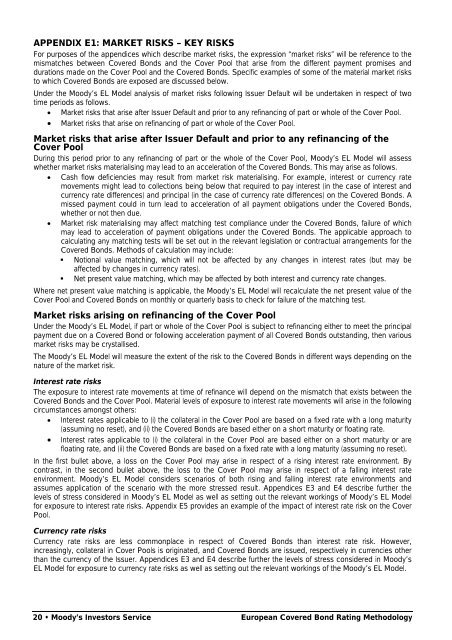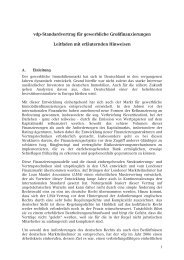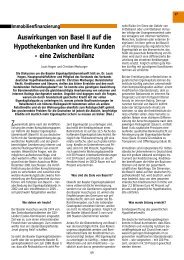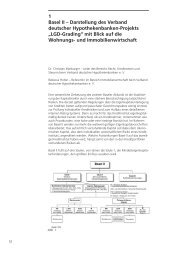Expected Loss Covered Bond Model
Expected Loss Covered Bond Model
Expected Loss Covered Bond Model
You also want an ePaper? Increase the reach of your titles
YUMPU automatically turns print PDFs into web optimized ePapers that Google loves.
APPENDIX E1: MARKET RISKS – KEY RISKS<br />
For purposes of the appendices which describe market risks, the expression “market risks” will be reference to the<br />
mismatches between <strong>Covered</strong> <strong>Bond</strong>s and the Cover Pool that arise from the different payment promises and<br />
durations made on the Cover Pool and the <strong>Covered</strong> <strong>Bond</strong>s. Specific examples of some of the material market risks<br />
to which <strong>Covered</strong> <strong>Bond</strong>s are exposed are discussed below.<br />
Under the Moody’s EL <strong>Model</strong> analysis of market risks following Issuer Default will be undertaken in respect of two<br />
time periods as follows.<br />
• Market risks that arise after Issuer Default and prior to any refinancing of part or whole of the Cover Pool.<br />
• Market risks that arise on refinancing of part or whole of the Cover Pool.<br />
Market risks that arise after Issuer Default and prior to any refinancing of the<br />
Cover Pool<br />
During this period prior to any refinancing of part or the whole of the Cover Pool, Moody’s EL <strong>Model</strong> will assess<br />
whether market risks materialising may lead to an acceleration of the <strong>Covered</strong> <strong>Bond</strong>s. This may arise as follows.<br />
• Cash flow deficiencies may result from market risk materialising. For example, interest or currency rate<br />
movements might lead to collections being below that required to pay interest (in the case of interest and<br />
currency rate differences) and principal (in the case of currency rate differences) on the <strong>Covered</strong> <strong>Bond</strong>s. A<br />
missed payment could in turn lead to acceleration of all payment obligations under the <strong>Covered</strong> <strong>Bond</strong>s,<br />
whether or not then due.<br />
• Market risk materialising may affect matching test compliance under the <strong>Covered</strong> <strong>Bond</strong>s, failure of which<br />
may lead to acceleration of payment obligations under the <strong>Covered</strong> <strong>Bond</strong>s. The applicable approach to<br />
calculating any matching tests will be set out in the relevant legislation or contractual arrangements for the<br />
<strong>Covered</strong> <strong>Bond</strong>s. Methods of calculation may include:<br />
• Notional value matching, which will not be affected by any changes in interest rates (but may be<br />
affected by changes in currency rates).<br />
• Net present value matching, which may be affected by both interest and currency rate changes.<br />
Where net present value matching is applicable, the Moody’s EL <strong>Model</strong> will recalculate the net present value of the<br />
Cover Pool and <strong>Covered</strong> <strong>Bond</strong>s on monthly or quarterly basis to check for failure of the matching test.<br />
Market risks arising on refinancing of the Cover Pool<br />
Under the Moody’s EL <strong>Model</strong>, if part or whole of the Cover Pool is subject to refinancing either to meet the principal<br />
payment due on a <strong>Covered</strong> <strong>Bond</strong> or following acceleration payment of all <strong>Covered</strong> <strong>Bond</strong>s outstanding, then various<br />
market risks may be crystallised.<br />
The Moody’s EL <strong>Model</strong> will measure the extent of the risk to the <strong>Covered</strong> <strong>Bond</strong>s in different ways depending on the<br />
nature of the market risk.<br />
Interest rate risks<br />
The exposure to interest rate movements at time of refinance will depend on the mismatch that exists between the<br />
<strong>Covered</strong> <strong>Bond</strong>s and the Cover Pool. Material levels of exposure to interest rate movements will arise in the following<br />
circumstances amongst others:<br />
• Interest rates applicable to (i) the collateral in the Cover Pool are based on a fixed rate with a long maturity<br />
(assuming no reset), and (ii) the <strong>Covered</strong> <strong>Bond</strong>s are based either on a short maturity or floating rate.<br />
• Interest rates applicable to (i) the collateral in the Cover Pool are based either on a short maturity or are<br />
floating rate, and (ii) the <strong>Covered</strong> <strong>Bond</strong>s are based on a fixed rate with a long maturity (assuming no reset).<br />
In the first bullet above, a loss on the Cover Pool may arise in respect of a rising interest rate environment. By<br />
contrast, in the second bullet above, the loss to the Cover Pool may arise in respect of a falling interest rate<br />
environment. Moody’s EL <strong>Model</strong> considers scenarios of both rising and falling interest rate environments and<br />
assumes application of the scenario with the more stressed result. Appendices E3 and E4 describe further the<br />
levels of stress considered in Moody’s EL <strong>Model</strong> as well as setting out the relevant workings of Moody’s EL <strong>Model</strong><br />
for exposure to interest rate risks. Appendix E5 provides an example of the impact of interest rate risk on the Cover<br />
Pool.<br />
Currency rate risks<br />
Currency rate risks are less commonplace in respect of <strong>Covered</strong> <strong>Bond</strong>s than interest rate risk. However,<br />
increasingly, collateral in Cover Pools is originated, and <strong>Covered</strong> <strong>Bond</strong>s are issued, respectively in currencies other<br />
than the currency of the Issuer. Appendices E3 and E4 describe further the levels of stress considered in Moody’s<br />
EL <strong>Model</strong> for exposure to currency rate risks as well as setting out the relevant workings of the Moody’s EL <strong>Model</strong>.<br />
20 • Moody’s Investors Service European <strong>Covered</strong> <strong>Bond</strong> Rating Methodology

















